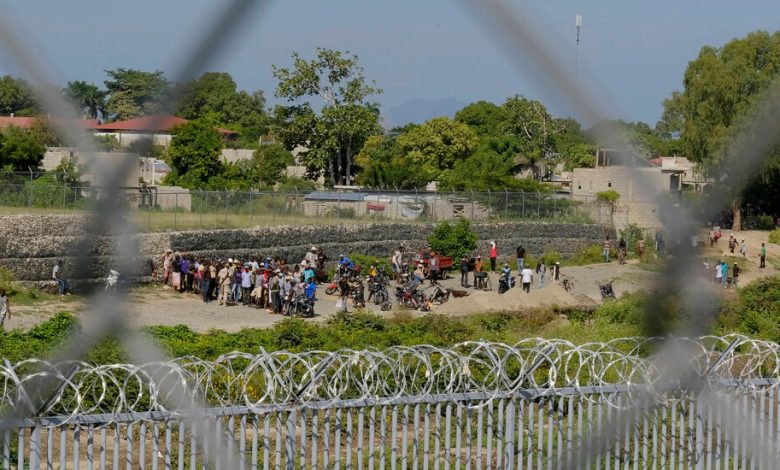A Different Border Crisis Mirrors What’s Happening in the U.S.

Haiti and the Dominican Republic together make up the island of Hispaniola. These countries are linked by histories of colonialism, slavery, dictatorships and U.S. military interventions.
Though at times they have come together to fight for sovereignty and justice or to confront the aftermaths of environmental disasters, this legacy has not united the two nations. Theirs has been a history splintered with xenophobia, colorism and violence that has seethed into the present day.
In September the Dominican president, Luis Abinader, sealed all land, air and sea borders with Haiti, prohibiting the passage of goods and people and denying all visas to Haitian citizens, as retaliation for what he considers to be Haiti’s illegal construction of an irrigation canal on a shared river, Rio Massacre. Haiti’s government said its farmers need the water to grow crops, while Mr. Abinader claims it will divert water needed by Dominican farmers.
The border closures reinforced the dangerous nativist Dominican rhetoric Mr. Abinader and his government have deployed in their efforts to contain Haitian immigration. Claims that Haitians are invading have led to the banning of Haitians from public transit, mass deportations and, reportedly, looting of Haitian-owned residences.
The president partly reopened the border for some commerce on Oct. 11. Haitians are still barred from entering the Dominican Republic, including for emergency medical assistance.
The Dominican borderlands, known as La Línea Fronteriza, stretch more than 240 miles and are home to a vibrant interethnic and multicultural community of people of Haitian and Dominican ancestry.
Many people from La Línea have family on either side of the border, and until Mr. Abinader sealed it off, crossed often, sometimes daily, to attend church or school or to seek medical care. The area is also an important site of commerce for Dominican farmers and traders. The border’s fluidity has been central to the livelihood of communities on both sides of the island since colonial times.
Because of the gang violence gripping Haiti and the country’s lack of a functional government, opening the border to commerce for Haitians and for those aiding them is critical. The Dominican Republic and the rest of the international community, particularly the United States, must take effective and compassionate measures that can support Haitians.
Late last year, the Biden administration said it would allow more than 100,000 additional Haitians to apply for temporary protected status, citing the extraordinary conditions in the crisis-ridden country. The homeland security secretary, Alejandro Mayorkas, extended temporary protected status for Haitians through August 2024 and redesignated it to allow Haitian nationals residing in the United States as of November 2022 to apply.
It’s a step in the right direction, but Washington and others can and should do more, including halting all deportations of Haitian migrants escaping violence.
The crisis along the Haitian-Dominican border is part of the history of anti-Haitian racism and xenophobia institutionalized during Rafael Trujillo’s dictatorship, from 1930 to 1961, which has its roots in the colonial projects that shaped the sides of the island to be different from each other.
In the late 17th century, the island was divided between Spain and France. In 1822 the two sides were united under the Haitian flag. But a group of men from the Spanish-speaking portion of the island moved to sever ties with Haiti, in part to avoid crippling debt to enslavers and insert themselves in the global market. They used linguistic and cultural differences to garner popular support.
The Dominican Republic established itself as different from Haiti in 1844.
In 1915 the United States invaded Haiti and the next year occupied the entire island, establishing a national guard and creating a worker program that sent Haitian workers to the Dominican Republic to cut cane in the nation’s American-owned sugar factories.
When the Americans left, Mr. Trujillo, who had been trained by U.S. Marines during the occupation, became president. The dictator, who envisioned a non-Black nation, institutionalized a campaign that portrayed Haitians as culturally and racially inferior. In October 1937 he ordered the massacre of over 20,000 Haitians and Dominicans of Haitian descent along the river at the center of today’s dispute.
In September 2013 the Dominican Constitutional Court issued a ruling that retroactively denied Dominican nationality to anyone born after 1929 who did not have at least one parent of Dominican heritage. The ruling, known as La Sentencia (the sentence), was aimed at controlling undocumented immigration from Haiti. In practice, it effectively left stateless an estimated 200,000 Dominican citizens of Haitian descent.
The ruling prompted anger from the international community. In 2014 the Dominican Republic offered a stopgap solution in the form of a law that, in theory, offers a path to legalization for those stripped of citizenship the year before. Yet thousands of Dominicans of Haitian descent continue to face deportation and human rights abuses as a result of their legal status. In 2022 alone, more than 150,000 people were deported.
The crisis along the border is another example of a global trend in which nativist and extreme nationalist rhetoric is being weaponized by government officials seeking to garner popular support.
In some ways what is happening on the Haitian-Dominican border echoes the reversal of basic civil rights in the United States. In 2013 as the Dominican Republic issued La Sentencia and we saw a deportation surge under the Obama administration, I implored readers to reflect on the United States’ role in the propagation of extreme ideas about immigration that harked back to Jim Crow and apartheid. Since then, children have been separated from their parents at the southern border, travel bans were aimed at Muslims, and migrants were rounded up on buses and sent elsewhere.
In years since, I have traded my optimism for vigilance. I invite you all to do the same. If you value freedom and justice, you must stay alert, get involved, be aware. Like many Dominicans, some Americans, particularly those of us who identify as Black, brown or descendants of immigrants, could well find ourselves without a country, suddenly illegal in our own home.
Lorgia García Peña, a professor at Princeton University, is the author, most recently, of “Translating Blackness: Migrations of Latinx Colonialities in Global Perspective.”
The Times is committed to publishing a diversity of letters to the editor. We’d like to hear what you think about this or any of our articles. Here are some tips. And here’s our email: [email protected].
Follow The New York Times Opinion section on Facebook, Twitter (@NYTopinion) and Instagram.



